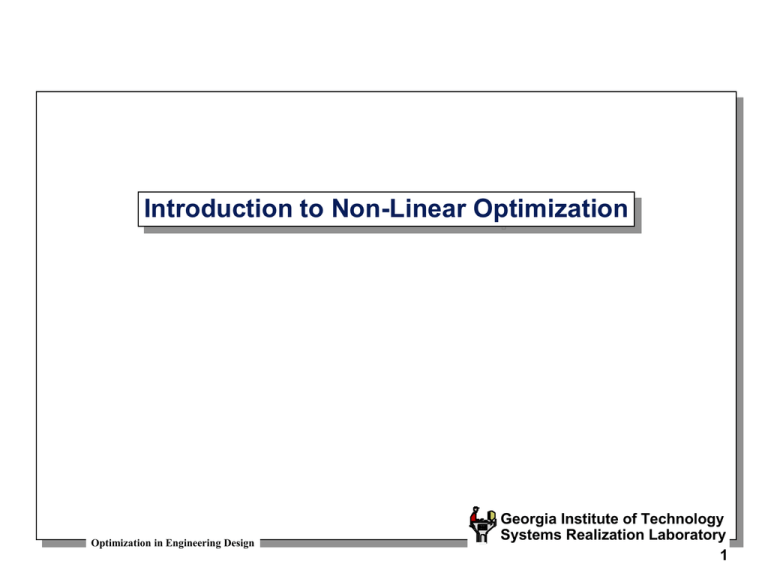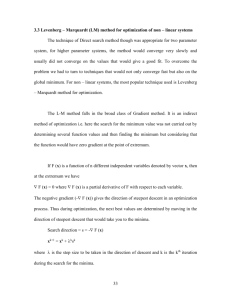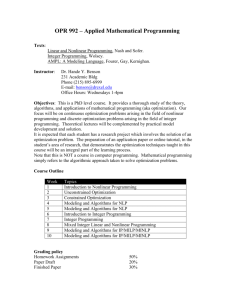Nonlinear Optimization
advertisement

Introduction to Non-Linear Optimization Optimization in Engineering Design Georgia Institute of Technology Systems Realization Laboratory 1 Nonlinear Optimization Note: Unlike for linear problems, a global optimum for a nonlinear problem cannot be guaranteed, except for special cases, e.g., if you know the space is unimodal, or convex, or monotonicity exists. Two standard heuristics that most people use: 1) find local extrema starting from widely varying starting points of the variables and then pick the most extreme of these extrema (if they are not the same) 2) perturb a local extremum by taking a finite amplitude step away from it, and then see whether your routine returns you to a better point or "always" to the same one. Question: How would you "automate" a search for a global extremum? Optimization in Engineering Design Georgia Institute of Technology Systems Realization Laboratory 2 Basic Steps in Nonlinear Optimization • In its simplest form, a numerical search procedure consists of four steps when applied to unconstrained minimization problems: 1) Selection of an initial design in the n-dimensional space, where n is the number of design variables 2) A procedure for the evaluation of the function (objective function) at a given point in the design space. 3) Comparison of the current design with all of the preceding designs. 4) A rational way to select a new design and repeat the process. • Constrained minimization requires step for evaluation of constraints as well. Same applies for evaluating multiple objective functions. Optimization in Engineering Design Georgia Institute of Technology Systems Realization Laboratory 3 Nonlinear Optimization Process • Simplistically, most design tasks seek to find a perturbation to an existing design which will lead to an improvement. Thus, we seek a new design which is the old design plus a change: Xnew = Xold + d X • Optimization algorithms use the same formula, but apply a two step process: Xk = Xk-1 + aSk • You (the engineer) have to provide an initial design X0. • The optimization will then determine a search direction S k that will improve the • design. Next question is how far we can move in direction Sk before we must find a new search direction. This is a one-dimensional search since we only have to determine the value of the scalar a to improve the design as much as possible. Optimization in Engineering Design Georgia Institute of Technology Systems Realization Laboratory 4 A Good Algorithm A good algorithm is (among others): • Robust – algorithm must be reliable for general design applications and (thus) must theoretically converge to the solution point starting from any given starting point. • • • • General – Should not impose restrictions on the model's constraints and objective functions. Accurate – Ability to converge to precise mathematical optimum point is important, though it may not be required in practice. Easy to use – by both experienced and inexperienced users. Should not have problem dependent tuning parameters. Efficient – To be efficient, the number of repeated analyses should be kept to a minimum. Hence, an efficient algorithm has 1) a faster rate of convergence requiring fewer iterations, and 2) least number of calculations within one (design) iteration. Note: Tradeoffs have to be made Optimization in Engineering Design Georgia Institute of Technology Systems Realization Laboratory 5 Zero and first order algorithms • You often must choose between algorithms which need only evaluations of the objective function or methods that also require the derivatives of that function. • Algorithms using derivatives are generally more powerful, but do not always compensate for the additional calculations of derivatives. • Note that you may not be able to compute the derivatives. Optimization in Engineering Design Georgia Institute of Technology Systems Realization Laboratory 6 Basic Descent Methods • Basic descent methods are the basic techniques for iteratively solving unconstrained minimization problems. • Important for practical situations because they offer the simplest and most direct alternatives for obtaining solutions. • Also good as a benchmark. Optimization in Engineering Design Georgia Institute of Technology Systems Realization Laboratory 7 General Basic Descent Method Algorithm Basic steps: 1. start at an initial point; 2. determine according to a fixed rule a direction of movement; and 3. move in that direction to a (relative) minimum of the objective function on that line. 4. At the new point, a new direction is determined and the same process is repeated. • The primary difference between algorithms (steepest descent, Newton's method, etc) is the rule by which successive directions of movement are selected. • The process of determining the minimum point on a line is called line search. Optimization in Engineering Design Georgia Institute of Technology Systems Realization Laboratory 8




